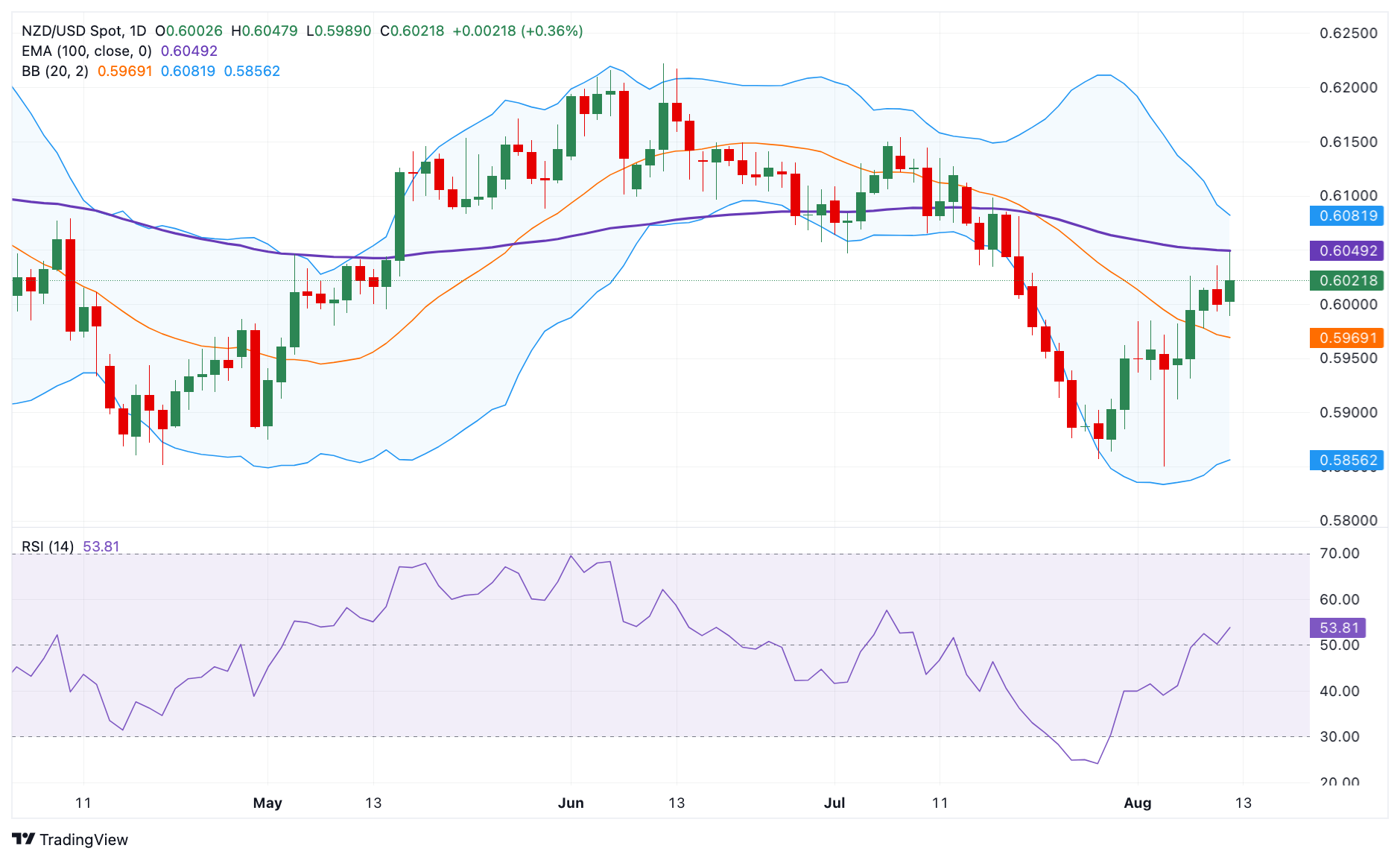- The New Zealand Dollar edges higher in Tuesday’s Asian session.
- Reduced bets for a RBNZ rate cut and signs of stronger demand from China supported the Kiwi.
- Rising Middle East geopolitical risks might limit the pair’s downside.
- The US Producer Price Index (PPI) will be in the spotlight on Tuesday before the RBNZ rate decision.
The New Zealand Dollar (NZD) trades on a stronger note on Tuesday amid the modest decline of the Greenback. The stronger-than-expected New Zealand employment report last week diminished the possibility of the Reserve Bank of New Zealand (RBNZ) rate cut on Wednesday, which continues to support the Kiwi. Additionally, signs that Chinese demand is improving could contribute to the NZD’s upside as China is New Zealand's largest trading partner.
On the other hand, safe-haven buying amid elevated geopolitical tensions in the Middle East might push the US Dollar (USD) higher. The RBNZ interest rate decision and press conference on Wednesday will be closely watched. The hawkish messages from RBNZ Governor Adrian Orr might lift the NZD against the USD in the near term. Elsewhere, traders will keep an eye on the US economic data, which should shed further light on the Federal Reserve’s (Fed) outlook for rates. The Producer Price Index (PPI), Consumer Price Index (CPI) and Retail Sales will be released on Tuesday, Wednesday and Thursday, respectively.
Daily Digest Market Movers: New Zealand Dollar gains ground, with all eyes on RBNZ Interest Rate Decision
- ING’s FX analysts Francesco Pesole and Chris Turner noted, “We narrowly favor a hold in August but see a greater chance that the RBNZ will cut 50 bps in October after the Fed has moved first. Ultimately, with over 90 bps of easing priced in by year-end, the difference between a hawkish cut and a dovish hold may not be huge: we still think easing bets can be trimmed by year-end.”
- 12 of 21 economists surveyed by Bloomberg expect the RBNZ to leave its OCR unchanged at 5.5% on Wednesday.
- Over half of the NZIER Shadow Board expects a 25 bps reduction in the OCR is required due to the persistent weakening of the New Zealand economy. The other members suggested that the New Zealand central bank should keep the OCR at 5.50%.
- The US Producer Price Index (PPI) is expected to drop to 0.1% MoM in July from 0.2% in June.
- Traders have priced in a nearly 47.5% chance that the Fed will cut the rate by 50 basis points (bps) in the September meeting, down from 52.5% last Friday, according to the CME FedWatch Tool.
Technical Analysis: New Zealand Dollar’s bearish trend prevails
The New Zealand Dollar trades stronger on the day. The bearish outlook of the NZD/USD pair remains intact on the daily chart as the pair holds below the key 100-day Exponential Moving Average (EMA). Nonetheless, if the price decisively crosses above the key EMA, it would resume the uptrend. Meanwhile, the 14-day Relative Strength Index (RSI) is slightly above the 50 midline, indicating a potential shift towards more bullish sentiment in the short term.
A bullish turn could expose NZD/USD to the 100-period EMA near 0.6050. Any follow-through buying above this level will see a rally to 0.6082, the upper boundary of the Bollinger Band. Further north, the next upside target emerges at 0.6134, a high of July 8.
On the flip side, a low of August 6 at 0.5912 acts as an initial support level for the pair. Extended losses below this level could pave the way to 0.5856, a low of July 29 and the lower limit of the Bollinger Band.

US Dollar price this week
The table below shows the percentage change of US Dollar (USD) against listed major currencies this week. US Dollar was the weakest against the .
| USD | EUR | GBP | CAD | AUD | JPY | NZD | CHF | |
| USD | -0.20% | -0.17% | 0.03% | -0.31% | 0.27% | -0.54% | 0.09% | |
| EUR | 0.20% | 0.04% | 0.24% | -0.09% | 0.47% | -0.33% | 0.29% | |
| GBP | 0.17% | -0.03% | 0.20% | -0.13% | 0.43% | -0.37% | 0.25% | |
| CAD | -0.04% | -0.25% | -0.21% | -0.32% | 0.22% | -0.58% | 0.05% | |
| AUD | 0.31% | 0.10% | 0.13% | 0.33% | 0.56% | -0.24% | 0.38% | |
| JPY | -0.24% | -0.46% | -0.44% | -0.25% | -0.57% | -0.80% | -0.17% | |
| NZD | 0.54% | 0.33% | 0.37% | 0.56% | 0.24% | 0.80% | 0.62% | |
| CHF | -0.10% | -0.29% | -0.26% | -0.05% | -0.39% | 0.17% | -0.63% |
The heat map shows percentage changes of major currencies against each other. The base currency is picked from the left column, while the quote currency is picked from the top row. For example, if you pick the Euro from the left column and move along the horizontal line to the Japanese Yen, the percentage change displayed in the box will represent EUR (base)/JPY (quote).
New Zealand Dollar FAQs
The New Zealand Dollar (NZD), also known as the Kiwi, is a well-known traded currency among investors. Its value is broadly determined by the health of the New Zealand economy and the country’s central bank policy. Still, there are some unique particularities that also can make NZD move. The performance of the Chinese economy tends to move the Kiwi because China is New Zealand’s biggest trading partner. Bad news for the Chinese economy likely means less New Zealand exports to the country, hitting the economy and thus its currency. Another factor moving NZD is dairy prices as the dairy industry is New Zealand’s main export. High dairy prices boost export income, contributing positively to the economy and thus to the NZD.
The Reserve Bank of New Zealand (RBNZ) aims to achieve and maintain an inflation rate between 1% and 3% over the medium term, with a focus to keep it near the 2% mid-point. To this end, the bank sets an appropriate level of interest rates. When inflation is too high, the RBNZ will increase interest rates to cool the economy, but the move will also make bond yields higher, increasing investors’ appeal to invest in the country and thus boosting NZD. On the contrary, lower interest rates tend to weaken NZD. The so-called rate differential, or how rates in New Zealand are or are expected to be compared to the ones set by the US Federal Reserve, can also play a key role in moving the NZD/USD pair.
Macroeconomic data releases in New Zealand are key to assess the state of the economy and can impact the New Zealand Dollar’s (NZD) valuation. A strong economy, based on high economic growth, low unemployment and high confidence is good for NZD. High economic growth attracts foreign investment and may encourage the Reserve Bank of New Zealand to increase interest rates, if this economic strength comes together with elevated inflation. Conversely, if economic data is weak, NZD is likely to depreciate.
The New Zealand Dollar (NZD) tends to strengthen during risk-on periods, or when investors perceive that broader market risks are low and are optimistic about growth. This tends to lead to a more favorable outlook for commodities and so-called ‘commodity currencies’ such as the Kiwi. Conversely, NZD tends to weaken at times of market turbulence or economic uncertainty as investors tend to sell higher-risk assets and flee to the more-stable safe havens.
Information on these pages contains forward-looking statements that involve risks and uncertainties. Markets and instruments profiled on this page are for informational purposes only and should not in any way come across as a recommendation to buy or sell in these assets. You should do your own thorough research before making any investment decisions. FXStreet does not in any way guarantee that this information is free from mistakes, errors, or material misstatements. It also does not guarantee that this information is of a timely nature. Investing in Open Markets involves a great deal of risk, including the loss of all or a portion of your investment, as well as emotional distress. All risks, losses and costs associated with investing, including total loss of principal, are your responsibility. The views and opinions expressed in this article are those of the authors and do not necessarily reflect the official policy or position of FXStreet nor its advertisers. The author will not be held responsible for information that is found at the end of links posted on this page.
If not otherwise explicitly mentioned in the body of the article, at the time of writing, the author has no position in any stock mentioned in this article and no business relationship with any company mentioned. The author has not received compensation for writing this article, other than from FXStreet.
FXStreet and the author do not provide personalized recommendations. The author makes no representations as to the accuracy, completeness, or suitability of this information. FXStreet and the author will not be liable for any errors, omissions or any losses, injuries or damages arising from this information and its display or use. Errors and omissions excepted.
The author and FXStreet are not registered investment advisors and nothing in this article is intended to be investment advice.
Recommended content
Editors’ Picks

EUR/USD regains traction above 1.1000 ahead of US CPI release
EUR/USD has found fresh buyers and jumps above 1.1000 in the European session on Thursday. The pair gains on the German coalition deal and Trump's 90-day pause on reciprocal tariffs, which have lifted risk senitment while exacerbating the US Dollar pain ahead of the US CPI data release.

GBP/USD trades firm above 1.2850, US CPI data awaited
GBP/USD sustains the rebound above 1.2850 in European trading hours on Thursday. The British Pound capitalizes on risk appetite, courtesy of Trump's tariff pause, allowing the pair to recover ground. But further upside hinges on the US CPI data and US-Sino trade updates.

Gold price eases from weekly top amid risk-on mood; still well bid above $3,100 ahead of US CPI
Gold price trims a part of its strong intraday gains to a one-week high touched during the early European session on Thursday and currently trades just above the $3,100 mark. Concerns about escalating US-China trade tensions, along with fears about a tariffs-driven economic slowdown, turn out to be key factors that continue to underpin the safe-haven bullion.

US CPI data set to reveal March inflation dip as markets weigh impact of Trump’s tariffs
As measured by the CPI, inflation in the US is set to rise at an annual pace of 2.6% in March, down slightly from the 2.8% reported in February. Core CPI inflation, which excludes the volatile food and energy categories, is expected to ease to 3% in the same period from a year earlier

Trump’s tariff pause sparks rally – What comes next?
Markets staged a dramatic reversal Wednesday, led by a 12% surge in the Nasdaq and strong gains across major indices, following President Trump’s unexpected decision to pause tariff escalation for non-retaliating trade partners.

The Best brokers to trade EUR/USD
SPONSORED Discover the top brokers for trading EUR/USD in 2025. Our list features brokers with competitive spreads, fast execution, and powerful platforms. Whether you're a beginner or an expert, find the right partner to navigate the dynamic Forex market.



